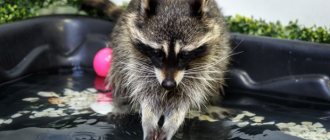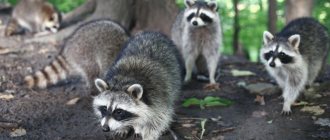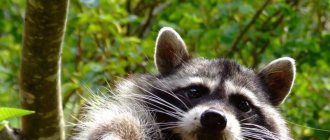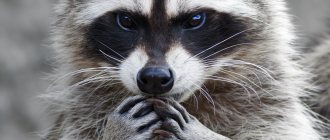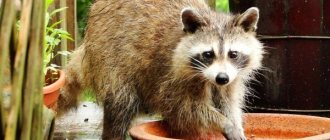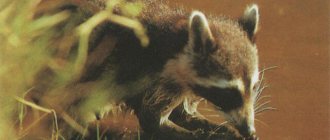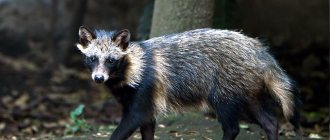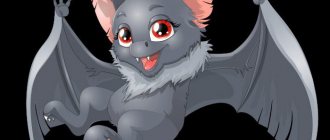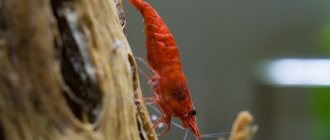The raccoon is a rather unusual pet, however, this is not the only reason why it attracts attention. But don't rush to start it. You need to become familiar with a number of nuances regarding its content. If you pay enough attention to him, you will be able to provide him with comfort even in an ordinary city apartment.
After all, it is practically no different from traditional domestic animals and can eat almost any food and easily adapts to urban conditions.
Raccoon at home: pros and cons
Before purchasing a raccoon, carefully weigh the pros and cons.
Before you get a raccoon at home, you need to study its character, requirements for living conditions and evaluate the possible consequences of such a decision. After all, these animals have become known as rascals. Therefore, you should carefully weigh the pros and cons, taking into account the habits of the raccoon.
Advantages
- Raccoons are extremely unpretentious. The food consists of the most common foods: fruits, vegetables, fish, meat, as well as standard dog or cat food.
- These animals are smart and quick-witted. They easily copy habits and imitate the actions of their owner. Such character traits appeal to many breeders.
- The animals are curious and sociable. You will not be bored next to such a pet. They are no strangers to empathy; the animals will happily play with their owner. They especially love rattles, the sound of which makes them truly delighted.
- All raccoons are clean animals, so you won’t notice any foreign odors from them.
- In the wild, animals can live on average up to 6-10 years. At home, this figure reaches 13-20 years, since the animal is in very good health. Under favorable conditions, you can also extend the average lifespan of your pet.
Flaws
- Raccoons are nocturnal animals, so you need to be prepared for the fact that the animal will disturb the restful sleep of its owners.
- The name “gargle” was not received without reason. This animal will wash everything that gets in its way. Valuable items and equipment are often damaged.
- This pet is extremely difficult to completely tame. Do not forget that a raccoon is a wild animal whose instincts and habits cannot be eradicated.
- Animals are pugnacious, they bite and scratch painfully even during games.
- The gargle does not recognize prohibitions and will do everything exactly as he wants.
- During puberty, raccoons become extremely aggressive.
- The pet should not be kept in a house with small animals - birds, rodents, kittens and others. He will gladly feast on such “prey”. The same goes for indoor plants.
- The striper marks its territory. It is almost impossible to toilet train this animal.
What do raccoons eat at home?
What to feed the striped raccoon is decided by its owner. The diet of a domestic raccoon should be complete and varied, rich in proteins, not oversaturated with fats and carbohydrates.
A raccoon's diet at home should include:
- lean meat, including veal, rabbit, poultry, offal (stomachs, liver, hearts),
- fish, with the exception of red fish,
- raw eggs,
- fiber (fruits and vegetables),
- cereals, mainly rice and buckwheat,
- various nuts - almonds, pistachios, hazelnuts,
- dairy and lactic acid products such as kefir, cottage cheese, etc.
Dairy products
Domestic raccoons should eat according to a regular diet. They are fed 3 times a day - morning, afternoon and evening, sometimes another, fourth feeding is introduced.
Attention! It is imperative to ensure constant access to drinking water - place a bowl of water in a corner and constantly replenish it. A raccoon may not even drink from it - but it simply needs to rinse its food in it: this is how the animal instinctively protects itself from unnecessary diseases
Dried fruits - dried apricots, figs, prunes, raisins - can be an excellent treat for a raccoon at home. Sometimes you can give a drop of honey.
It is preferable to feed the raccoon with products that have undergone minimal heat treatment. At the same time, raw fish and meat can become a source of disease, carriers of infections and bacteria, so their introduction into the diet is undesirable. Low-calorie foods are best given in the morning, while evening feeding is the main one.
Food should be seasonal: in the autumn it is better to give preference to plant components, in the winter - meat and cereals. Domestic raccoons do not hibernate, becoming slightly less mobile and active.
The condition of the raccoon's fur will indicate its adequate nutrition. If it becomes dull and begins to fall out, you can be sure: the raccoon does not have enough vitamins. Beaphar vitamin complexes and biological supplements are what you need in conditions of vitamin deficiency.
Dried fruits
Features of behavior and character
Raccoons are freedom-loving and curious creatures
Raccoons are not meant to be pets. Therefore, in character they differ significantly from the dogs and cats we are used to. Stripes are capricious, nimble, cunning, freedom-loving and active animals that are distinguished by their irrepressible curiosity and restlessness. The latter often leads to damage to the owner’s property and nerves. However, if you decide to have this exotic pet at home, you must come to terms with the habits of the animal and accept it with all its shortcomings. Therefore, do not resort to physical punishment, instead spend more time on raising the animal.
Beautiful, smart and cheerful raccoons deserve to be treated kindly. The struggle for existence has led to the fact that stripers have extremely developed dexterity. In addition, these animals are nocturnal: during the day they sleep, and in the dark they prowl in search of food and interesting adventures.
By temperament, raccoons are choleric people who quickly react to potential dangers around them. This should be taken into account when keeping an animal in the house; sudden movements and noises can cause a defensive response from the raccoon. And you shouldn’t think that these animals are completely harmless - raccoons are not afraid to show their temper. They know how to fight and do it with enviable consistency.
Important! When the gargle feels real danger, it cleverly pretends to be dead. Don't be alarmed if you see a picture like this.
Try not to offend your pet, as these cute furballs are actually quite vindictive. Just one moment, and the cute baby will turn into an aggressive beast. So do not provoke your pet to demonstrate such habits.
Raccoons are very unpretentious in food: meat, eggs, vegetables, nuts - everything will go into use. In a field where cereal crops grow, they have complete freedom. And because of their passion for fruit, these animals often become unwanted guests in garden plots.
Prices for puppies
You can buy an adult raccoon for 3-5 thousand rubles. For that kind of money they offer either wild animals or those that someone has given up. Often, raccoons are even given away for free into good hands, which means that the former owner simply couldn’t handle it. There are also situations when a raccoon bites off a child’s nose or someone’s finger (real cases!).
Almost always, when it's cheap, it's a sign that it's going to be difficult. At a minimum, you need to have a large separate balcony or room with a fenced enclosure where the raccoon will live.
There are situations when a tamed raccoon is sold for 10-15 thousand for objective reasons. For example, because there is no demand, and the family needs to go somewhere. It happens that people’s circumstances have changed, they have a child, someone in the family gets sick, and the animal does not allow them to sleep normally, they are allergic to it, and so on. Urgent sales at the raccoon market are commonplace.
Prices for raccoon puppies in rubles:
| Breed | Price |
| Manual | 35000-80000 |
| Aviary | 35000-40000 |
| Wild | 3000-15000 |
Wild raccoons are supplied en masse from the Caucasus and Krasnodar Territory. They exterminate poultry and kittens there, and often bite people.
Hunting for this animal is allowed only from November to February; in the off-season they are sometimes caught in traps, but more often pups are taken from hollows or old holes.
This is a kind of way to earn money for the local population. Not very humane? But anything is better than killing. Although, in truth, we would leave these animals in nature, where they are quite harmless.
The average price of a raccoon in Russian cities is approximately as follows:
| City | RUB |
| Moscow | 45000 |
| Saint Petersburg | 40000 |
| Novosibirsk | 55000 |
| Ekaterinburg | 45000 |
| Nizhny Novgorod | 60000 |
| Kazan | 50000 |
| Chelyabinsk | 45000 |
| Omsk | 52000 |
| Samara | 35000 |
| Rostov-on-Don | 30000 |
| Ufa | 50000 |
| Krasnoyarsk | 55000 |
| Permian | 45000 |
| Voronezh | 40000 |
| Volgograd | 35000 |
| Krasnodar | 20000 |
| Saratov | 35000 |
| Tyumen | 40000 |
| Tolyatti | 35000 |
| Izhevsk | 43000 |
| Barnaul | 35000 |
| Irkutsk | 40000 |
| Ulyanovsk | 40000 |
| Khabarovsk | 55000 |
| Yaroslavl | 45000 |
| Sergiev Posad | 50000 |
| Vladivostok | 75000 |
| Makhachkala | 15000 |
| Tomsk | 65000 |
These are approximate prices for the striped raccoon breed, which were identified in nurseries and private advertisements. It is the rinsers that are kept at home.
But there are also exotic species of raccoons, which are bought mainly by amateurs, as well as owners of private zoos. They are much more expensive and sometimes require specific food (like crayfish, mollusks, and so on). Many species have a single, unique value.
The price for these raccoons in Russia is approximately as follows:
| Breed | Price |
| Tresmarias raccoon (large) | 150,000 + delivery from Mexico |
| Barbados raccoon (island) | From 25,000,000 rubles |
| Bahamian raccoon (dwarf) | From 250,000 rub. |
| Cozumel raccoon (miniature) | From 340,000 rub. |
| Raccoon-eater | From 1,500,000 rubles |
| Guadalupe raccoon | From 15,000,000 rub. |
| Northern raccoon (Mexico, Canada) | From 10,000,000 rubles. |
Anything more than 2 million rubles are unique and rare animals. Usually under international protection, their sale occurs through a number of agreements, often at the political level.
Conditions of detention
If difficulties do not frighten you, and you want to have this cute wayward animal at home, then it will be useful to learn about the conditions of keeping a raccoon.
The enclosure must be free and safe
If you live in a private house, then you can build an aviary right in the yard. This way you can avoid the destructive consequences and damage to property from the pranks of a raccoon. But if you have an apartment, then you should allocate a separate corner for your pet, where he can live comfortably.
In an outdoor enclosure, it is imperative to provide windows with bars and tightly closing doors so that the pet does not escape. Also make sure that there is nothing inside that could harm the health of the gargle.
The home should have a comfortable temperature in winter (not lower than -3°C), and in summer the enclosure should not be hot. Make sure there is diffused light, without direct sunlight. For the raccoon, you also need to install an improvised hollow made of driftwood, where he can hide.
The apartment enclosure should be spacious. Usually it is built the size of a standard closet (1.5 * 0.75 * 1.2 m). The frame of the structure is made of beams with a cross-section of 50*50 mm, and the side and rear walls are sheathed with moisture-resistant plywood, the thickness of which is 10 mm. Inside the enclosure you need to provide several shelves. The front wall is made of mesh. Its cells should be of such a diameter that the raccoon cannot reach through them with its paws to objects of interest (curtains, furniture, wallpaper). Sawdust is suitable as a filler for the enclosure.
In the cage you need to put a sleeping place, a tray in which the pet will go to the toilet, a feeding trough and a bowl of water. It is better to choose a deeper one so that your pet can rinse his toys in it. Please note that you will need to clean such a home and change the water every day.
Raccoon raccoon - reviews
Stepan Morkovkin
https://flap.rf/Animals_and_plants/Raccoon/Reviews/7191027
because the whole life of a raccoon is inextricably linked with water. First of all, he always rinses his food in water. Secondly, he often looks for crayfish and crabs and various shells in the water. The raccoon has very sensitive paws, which sometimes replace the raccoon's eyes, and cold water is not a hindrance to this. However, the raccoon also has excellent night vision. But raccoons are omnivorous animals; they will not refuse lizards, snakes, mice, bird eggs, berries, fruits, nuts and acorns. What attracts me to a raccoon is its plasticity and its cheerful adaptability. They have settled perfectly into US cities... Now many owners have to install raccoon barriers on the roof, otherwise they will take up residence in the attics, which can lead to damage to the house. Curious animals try to gnaw and taste everything. In our country, the maximum that can be found is rats, and they have raccoons... However, raccoons, given the right conditions and the attention of their owners, make excellent pets. Video below.
anonymous
https://v_dguk.ukr/ru/raccoon_rinse-r1001987.html
I have never considered raccoons as pets.
But my friend’s dad dispelled my doubts with his example.
It turns out that raccoons can be kept at home and even in an apartment (but it’s better, of course, in a private house that has its own yard and where you can build a separate warm house for it)
A friend's father brought a raccoon from St. Petersburg, bought it for 35,000 with documents and vaccinations. He lives in their house. But on the street there is another special house and a decorative pond for him (in which, by the way, he bought half his food).
Looking at this miracle, you involuntarily think... that he is worth it!!! I have never seen such an active, restless pet... Tisha literally tried to stick his nose everywhere, even stealing food from the table several times. By the way, he eats everything, including vegetables he tried to steal fruits and meat and homemade food, and even caramels from us;) such an omnivorous beast.
He is very affectionate towards his owners!!! He treats strangers very well. He has never bitten anyone (although it is common for raccoons to bite).
In general, a cute charming animal!! If finances and home space allow why not :)
Zhanna
https://zoolog.guru/domashnie-zhivotnye/enot-poloskun-uhod-v-domashnih-usloviyah-otzyvy.html#i-6
Until a certain moment, I didn’t even think that raccoons could live in an ordinary city apartment. I considered them wild animals that could hardly get used to city life. And the first impression I got about raccoons was that they are a very troublesome animal to keep. But even despite all these shortcomings, it brings a lot of joy, since one cannot remain indifferent to this sweet and charming creature.
Kek Kekan
https://otzovik.com/review_4662123.html
Advantages:
Cute, evil
Flaws:
Shit sometimes
I recently bought myself a Raccoon. At first we didn’t get along with him, but then he began to recognize me as one of his own. After 1 month we were already friends with him, only sometimes he fought with the cat. He doesn’t ask for much to eat, but I give him the maximum, he’s always full. In general, I advise you to buy a Raccoon if you want some unusual pet for yourself.
sss2000sssa
https://otzovik.com/review_2344554.html
Advantages:
beautiful, smart, just a raccoon
Flaws:
There is not
A wonderful animal - a raccoon! You won't get bored with him. Loves his owners. You can put cool clothes on him, and he will even be happy: 3 An excellent choice for people who want a pet - this is a raccoon!
Angel123Slave
https://otzovik.com/review_5518341.html
Advantages:
The raccoon is a playful, cute creature. A kind of mother who will wash your socks or handkerchief.
Flaws:
It is better not to have a raccoon if there is a small child in the house. This will be a gang of mini criminals with their own laws.)
If there is a raccoon in the house, you should not have hamsters or birds. Raccoons are predators, so, unfortunately, small creatures will not live long. You also need to remember that raccoons are little robbers, so it’s better not to make cosmetic repairs in your house if you don’t already have one and you still want to have this charming creature. They tear sofas with their claws (especially if it is leather), tear up wallpaper, after washing the raccoon looks for the dirtiest place (in hard-to-reach places. For example, the space between the refrigerator and the wall) and crawling there, begins to cover its luxurious clean fur with dust.)
polovynka98
https://otzovik.com/review_2075231.html
Advantages:
read the review
Flaws:
read the review
I want to tell you about my cute, fluffy, gentle, mischievous, but beloved pet. It's not a rabbit, it's not a dog, it's not a kitten, it's not a poop... it's a raccoon. We got it a year ago, my godmother gave it to me. The little raccoon puppy has become a real member of the family. He is friends with the cat, loves me and my husband)) Raccoons are very exotic animals in our society. But very interesting and good. One minus, he is a terrible fidget)) He needs everything: open, take it out, turn it over, torment the cat, hide his husband’s socks. All this is funny, but sometimes troublesome. Below are photos of my cat and raccoon Kuzi. Are they really similar? A raccoon doesn’t just live in a house. We bought a huge cage for him, in which Kuzenka lives. He doesn’t walk around the apartment because he is very noisy and can mess up. During the day, it’s okay, he’s under supervision. But at night, when everyone is sleeping... except, of course, the raccoon, Kuzya sits in a cage. Our pet also loves to swim. He enjoys splashing in warm water and playing with shampoo bottles. The raccoon also loves to climb in flower pots. Checks)) Tramps his paws in the ground, scatters it around. That's why I decided to lay out a net. But this didn’t make me lose interest)) Also, a raccoon, like a dog, needs a walk. He goes to the toilet, as well as in the cat litter box, and outside. He climbs trees, pesters other dogs and sometimes doesn’t mind chasing cats. Raccoons also love to play with cat toys) Kuzya loves to hide. But unlike the cat, not for long. After all, the raccoon always needs to be close to us. But every day we regularly check the cabinets, shelves and air conditioning. We also have a summer house. And in the summer we take the cat and raccoon to the village to my mother. She loves my favorites. Kuzya endures the trip home quite calmly. Kuzya also helps me work)
lumusfly
https://irecommend.ru/content/zabavnoe-pushistoe-chudo
I got this little one six months ago. Funny fidget animal. He's constantly doing something like this. His paws are raking, he is always trying to steal something and drag it into the cage. This animal lives in my apartment. The content is not complicated at all. He eats everything, but mostly likes dog food. Loves fruits, especially if they are juicy. Very playful It’s worth putting him in a bathtub with water and you can sit next to him for a whole hour watching the fluffy frolic. And if you throw a bunch of toys into the water, then these water games can last much longer. As for the smell. Unlike ferrets, a raccoon does not smell, but it is better to clean up after it more often since raccoon excrement is odorous. In addition to the positive aspects, there are also negative ones, for example: during your absence, unfortunately, the animal cannot be left outside the cage, as it can make a terrible mess. Another disadvantage is that raccoons do not always sleep at night. Peak activity can last until 2-3 am. This means that this fluffy cutie can make all sorts of rattles in the cage, and can make peculiar rumbling sounds characteristic of raccoons, especially if the animal is not happy with something. It’s difficult to sleep under such noise, but in principle you can approach this moment creatively. A raccoon is very easy to get interested in. You can give him some soft toy or piece of paper at the peak of his activity and he will immediately be distracted by it. In the end, the animal gets used to a certain regime and is not particularly bothered at night. It happens that a raccoon can become fixated on a certain action, if he likes it, it looks funny. For example, my individual raccoon, sometimes when he doesn’t want to sleep at night, entertains himself with his tail. He tickles his nose with it and it makes him sneeze. At first I thought I was sick, but then I caught the bully and realized that after every sneeze, he again begins to rub his nose with his tail, like a feather. He also likes to tumble and hang like a monkey. And of course, like all raccoons, he strives to steal something. No matter what.
Safety of the raccoon and household members
Raccoons can ruin things and get into trouble themselves
Keeping a raccoon at home can be unsafe. Therefore, the following subtleties should be taken into account:
- The striper is jealous of other pets. Therefore, friendship with a cat or dog can be destructive, and in relation to smaller pets it can be completely disastrous. Raccoons can't stand competition.
- Often the owners themselves suffer from a selfish disposition. While still a baby, this animal can calmly explore the world around it, reach out to your arms and be very affectionate. But as puberty approaches, a raccoon can turn from a cute, friendly pet into an aggressive beast. Habitual caresses will seem like a challenge to him. Therefore, you should carefully monitor changes in your pet’s character and be wary of bites.
- For the safety of the striper itself, it is necessary to prudently seal all the cracks and gaps within its habitat. The raccoon will certainly poke its curious nose into every corner. In addition to the fact that it will spoil all existing things, the animal may get hurt or fall into electrical wires. Protect your home and pet from such consequences. Hide everything that should not fall into his tenacious paws.
Infant nutrition
The sooner you start accustoming a raccoon to your company, the more affectionate and kind this sneak will be when he becomes an adult. Of course, you need to know when to stop everything. For example, if you take custody of a recently born baby, there is an almost 100% chance that the baby will die. There is a raccoon, there is no raccoon.
If the raccoon owner is experienced and knows what to feed the raccoon at home and how to care for it, then you can try taking a baby 1 month old. Caring for such small raccoons is fraught with many difficulties. You need to be with the baby constantly; he wakes up every few hours and requires feeding and care.
The best option for a small raccoon is a 1.5-month-old rogue. His body is already considered more or less strong and he is able to handle man-made food for the gargle raccoon.
What do little raccoons eat? - Milk formulas. The food is poured into a baby bottle with a nipple (sold at any pharmacy). If you are nursing a month-old raccoon, it is better to feed the baby with an ordinary pipette.
Cow's or goat's milk is used as milk mixtures. The product is diluted with a small amount of warm water. You can sweeten the mixture with sugar. In addition, you can use high-quality condensed milk (condensed milk must be diluted) or dairy products for feeding cats.
Related material: How many raccoons are born from one female?
From the age of 1.5 months, the baby raccoon begins to try solid food. Grated banana, cottage cheese and quail egg are added to the milk mixture.
At the age of 2.5 months, a small raccoon can already eat from a bowl. Starting from 3 months, he himself begins to understand what domestic gargle raccoons eat, what is good for him and what is not.
Walking: is it worth it and how often?
Walking is a special joy for a raccoon
One of the striper's favorite activities is walking. A raccoon can be released at any time of the year. If you keep an animal in an apartment, then take into account the change in temperature conditions. Try to walk so that your pet gradually gets used to the street.
Important! A raccoon should only be walked on a leash. A harness for small breed dogs is used.
If you do not want to let your pet out of your home territory, he will need to be given free rein in an apartment. Try to release it every day, after removing all objects that could spoil the gargle from the path. Also make sure that all windows are closed. The same should be done with the doors of cabinets and bedside tables if you do not want all the contents to end up on the floor.
Important! Don't let the raccoon out of your sight so it doesn't end up in a dangerous situation.
Making a home for a raccoon
It is important to always remember that raccoons require a lot of space, despite their relatively small size. For a gargle dog, you need to allocate more space than for a dog of the Shepherd or Dalmatian breed. If the latter are satisfied with a soft bed in the corner of the room, then raccoons require labyrinths, a house, space for games, and a kind of mink. Before you get a raccoon, arrange a home for it.
- Cell.
Even if you are counting on free keeping, which involves the presence of a raccoon in all rooms of the apartment, buy a cage for your pet. The aviary will be especially useful in those moments when the owners leave the apartment or cannot sleep peacefully due to the fact that the gargle wanders from corner to corner. - Little house.
If desired, you can equip the cage cavity with a kind of house, the main thing is that it is not made of polystyrene foam, fabric or foam rubber. Give preference to plastic beds that are designed for small cats and dogs. It is desirable that the house be covered in the shape of a mink. Raccoons love the dark, so they often hide while they sleep. Place bowls for food and water near the house. - Rinse basin.
The main aspect that distinguishes the raccoon from other animals is that it loves to rinse. Take care of a basin with clean running water, which will be located next to the house. You can put a small piece of fabric in the container. You should not deprive the animal of its natural needs; rinsing is in the blood of raccoons. - Tray.
Equip the far corner of the cage with a tray. Teach your pet to relieve himself in a specially designated place, and not where he pleases. Such a move will help avoid “mines” when you let your pet run around the apartment. - Toys.
Raccoons are very playful and cheerful creatures. For a full-fledged existence, they need to have a large number of toys. Give preference to products made of fabric, but without padding polyester filling. If a raccoon swallows it, there is a risk of intestinal blockage and, as a result, death. Pet stores sell rattle toys for parrots and cats. Do not buy products made from painted rubber and silicone. Since raccoons are very smart and curious creatures, purchase a cube for the animal that consists of several sections.
how to care for a parrot at home
Animal care
Raccoons are very unpretentious in care. All you need to do is feed your pet regularly and perform hygiene procedures as needed. Let's look at the features of care in more detail.
What to feed and how often
The raccoon is very picky when it comes to food.
In nature, a raccoon’s life cycle is divided into periods of activity, and in winter it hibernates, so in the spring (sometimes until summer), its diet needs to be filled with food of animal origin, and closer to autumn-winter it should be switched to plant food. Please note that at this time the pet’s appetite increases several times.
Important! At home, the raccoon does not hibernate, but simply becomes less active. At this time, you need to reduce the amount of food consumed.
So, the raccoon’s diet needs to include: vegetables and fruits (in large quantities), seafood, fish (all except red fish), meat (poultry, veal, rabbit), porridge. Be careful when choosing cereals; you can feed your animal only buckwheat and oatmeal. Semolina does not saturate the gargle fish's body at all; in half an hour it will be hungry again. Consumption of rice leads to constipation, barley and millet cause diarrhea, and wheat and corn grits are poorly digestible.
Raccoons can also eat regular cat or dog food. But experts advise not to rush into such a decision and stick to a natural diet.
The following foods can be given to your rinse as a treat:
- nuts (pine, hazelnuts, almonds, cashews, walnuts, Brazil);
- quail eggs;
- dried fruits (dates, candied fruits, raisins, figs);
- grape.
Each animal has different gastronomic preferences. Watch your pet carefully, and he will tell you what ingredients and how much he needs to eat at a certain time of the year.
The frequency of feeding depends on appetite. As a rule, a raccoon eats 3-4 times a day, from the evening until the morning. It is also important not to forget about clean water - it should always be within your pet’s reach.
Products that are strictly contraindicated for gargles:
- flour;
- spicy, peppery;
- sweets (except honey);
- smoked;
- salty.
Video: gargle behavior while eating
Bathing and brushing
Bathing is more fun for a raccoon than a necessity.
Raccoons take care of their fur on their own, so you need to bathe your pet no more than 2-3 times a year. To do this, you can use regular shampoo for dogs or cats. During the rest of the year, you need to devote all your energy and time to frequent cleaning of the enclosure.
Features of living in the wild
The breeding season for raccoons depends on where they live and usually takes place in the spring. After mating, the males leave the mother, leaving her with the future offspring.
The following natural reproductive characteristics of raccoons are known:
- pregnancy lasts 63 days. To breed the babies, the female looks for a suitable hollow or burrow. As a rule, the mother looks at several options at once in case of danger or sudden escape;
- before giving birth, the female is characterized by aggressive behavior and does not allow anyone close to her;
- One litter can produce up to six adorable puppies. At the same time, the first baby is much larger and heavier than the others;
- All cubs are the same light brown color. After ten days, black spots become noticeable on the body;
- puppies begin to open their eyes after 1 month;
- babies feed on mother's milk until they are three months old. Children are under her care for up to five months;
- puppies are very loud. The call can be heard even from a long distance.
Puberty in offspring occurs at one year of age. Males mature a little later - at two years. The lifespan of raccoons depends entirely on their habitat and natural conditions. Pets can live 20 happy years with their owner.
How to make friends with your pet and stop him from biting?
You can tame a raccoon only from a young age
If you want to tame a raccoon, or at least get as close to this result as possible, try to take it when it is still a baby, until the animal reaches 4 months of age. The younger the puppy, the easier it is to raise him. However, don't be fooled into thinking that this will happen quickly.
Raccoons are not only smart, but also capricious. Therefore, when training, you need to convey to your pet that the only owner of the situation here is you. Also keep in mind that females always claim primacy more than males.
Important! When raising raccoons, keep in mind that they will never accept physical punishment. The animal regards this as an attack and attacks in response.
When raising a striper, you need to rely on its behavioral factors. If the animal behaves obediently, respond with affection and reward with a treat. Make this strategy as clear as possible, as other methods will be less effective.
Some owners use a special clicker, which can be purchased at a pet store. Using this simple device, you can develop a cause-and-effect relationship between the raccoon’s action and punishment through a sound signal. To suppress an unwanted action, the command “No!” is used.
Important! Raccoons perceive high-frequency sounds aggressively. Try to communicate with the animal in a low voice.
By the way, stripers love to bite. In this way they communicate with the “interlocutor”. It is almost impossible to wean your pet from this habit. If your animal bites too aggressively and does not understand commands, then you can only wear gloves when playing with it.
Sometimes it is simply impossible to pacify an angry raccoon. In this case, you can use a plastic bottle. Just knock the empty container near your pet and immediately say the command “No” in a low voice. The sound from the impact is voluminous and loud, which distracts the rinser’s attention. Over time, words alone will be enough for educational moments.
Upbringing
Training a raccoon should occur without the use of physical force. Otherwise, the animal will become the sworn enemy of its owner. For a wild animal, punishment is a kind of signal to respond. However, the breeder must gain undeniable authority from the pet, otherwise the wayward raccoon will become uncontrollable.
Parenting methods are based on the behavior of the furry pet. Obedience is rewarded with a favorite treat or a new toy. As for the “No” command, a plastic bottle will help in this case. If the owner of a wild animal disobeys, it is enough to hit the object on a hard surface, making a loud sound, and clearly pronounce the phrase: “Forbidden!”
Constant monitoring of the movement of a small pet is especially important. It is better to hide all cutting objects from him. It is also necessary to ensure that the baby does not swallow anything dangerous to his health.
It is useful for a domestic raccoon to take walks in the fresh air. For these purposes you will need a leash and a muzzle. It is necessary to accustom the animal to these accessories gradually. It is best to walk your pet in the morning or evening. In hot weather, the animal can get heatstroke, and severe frosts will put it in a lethargic state.
You can learn how to keep a raccoon at home by watching the video below.
Contraindications in food
A raccoon, like any other domestic animal, is contraindicated:
- everything sweet except honey,
- flour, especially freshly baked,
- spicy,
- smoked,
- everything is salty
- any seasonings.
The following should be offered to raccoons with restrictions:
- butter (it is better to use vegetable oil),
- corn and semolina porridge - they are poorly digestible and can negatively affect the gastrointestinal system,
- millet and pearl barley porridge - can weaken the animal,
- homemade cookies (if you give them, then hard ones),
- kibble food for dogs and cats is easy to use and affordable, but not the best option for raccoons.
Homemade cookies, think about whether they are really necessary?
It is contraindicated to feed raccoons food from the home table. Everything fried and fatty should be strictly excluded from his diet. An adult raccoon, like a baby, must have its own food and dishes. You can cook the porridge in meat/chicken broth and add buckwheat or oatmeal to it, as well as pre-boiled grated vegetables. This “minced meat” should become a raccoon’s main dish.
Raccoon food should not be rotten or moldy. You should not leave your animal’s health to chance by feeding it food made from products that have expired. There is no need to leave food in the feeder so that the raccoon will come and eat all that is left later: the food will most likely spoil and will be of little use.
You should choose treats for your raccoon with great care. You shouldn’t follow your pet’s lead: he may have his own taste preferences. Some people love healthy things like grapes or carrots, while others will be crazy about dry cat food, while others will absolutely love baby toffees.
With proper nutrition, a raccoon's lifespan can be up to 15 years. Give your pet a heavenly life with proper nutrition, and you won’t have to worry about his health! Unpretentious animals, smart and agile, will delight you with their presence and attractive appearance. And you will be proud to show them to your guests and friends!
https://youtu.be/TFrtge-euGo
Grapes, nuts and dried fruits
About 2 kg of grapes will be required per month. However, it is worth considering that not all raccoons love it. Therefore, you should not buy a lot of berries at once.
Raccoons can be given any nuts. A pet can eat up to 1.5 kilograms of almonds, cashews or other types of this treat per month. As a result, you need to be prepared to spend up to 700 rubles monthly on this.
Also, many pet owners note that their pets love dates, various candied fruits and raisins. You will also have to buy about 1 kg of them every month.
How to raise a raccoon?
If you want to raise a kind and sympathetic animal, then you need to devote a sufficient amount of time to this animal.
- You need to accustom him to your company from the cradle
- You need to endure all the pranks and playful manners with patience.
- You need to constantly communicate with the animal in a good manner
- You need to respond in time to the cries of the fluffy, which signal a lack of food or lack of attention.
As practice shows, a raccoon needs to devote about half of its personal free time. No less than that. More is possible.
How long does a striped raccoon live at home? – Stripes are excellent at living under the same roof as humans. A miracle with a striped tail can live up to 20 years, delighting caring owners with its existence every day.
Raccoons need to be trained to use a litter box and a leash from early childhood.
Related material: What to do if bitten by a raccoon?
Remember that raccoons have a fighting nature that becomes stronger once they reach sexual maturity. If you don’t instill love and care in your fluffy from the early months, then you risk getting an inveterate bully who may not even be handled. Sexual maturity occurs by 1 year in females and by 2 years in males.

